- Home
- Fishing Rigs
- Surf Fishing Rigs
The Surf Fishing Rigs
That Catch Fish!
Just how many surf fishing rigs do you need? Won't just one design do? Afraid not - no single rig will meet all your requirements - but you can be sure that a rig has already been designed for exactly the situation you're faced with.
For most of your surf fishing, you'll find that a simple Flapper Rig - either a one, two or three hook version - will best suit your needs.
But with all those baits flapping around you casting distance will be limited. So if you do need get your bait out further, you'll need to use the clipped-down version of the rig.
And for absolute maximum casting range - particularly with long droppers on the rig, nothing will beat the loop rig version.
Sometimes though, you'll want to put your bait into rough ground, where any of the rigs we've just mentioned will result in high tackle losses. The solution? Use the Pulley Rig.
So, that's the flapper rig, clipped rig, loop rig and pulley rig - just these four types of surf fishing rig then? Well to a degree yes, but each of these rig patterns have a number of variants, all of which you need to be aware of - and how to tie them and when to use them for successful surf fishing.
And here they are...
The Flapper Rig;
for Short or Medium Range Surf Fishing
These are the simplest and often most effective of all surf fishing rigs. In fact for all but the ultimate in long casting requirements you need look no further than one of the three variants shown below.
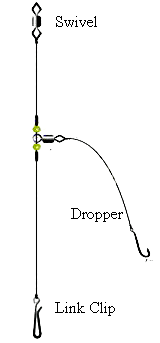 The simplest, one hook version of the flapper rig.
The simplest, one hook version of the flapper rig.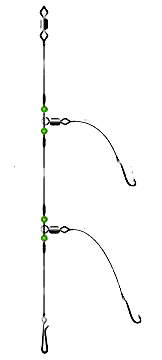 The two-hook flapper rig, one of the most productive surf fishing rigs.
The two-hook flapper rig, one of the most productive surf fishing rigs.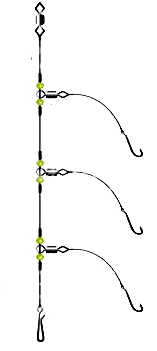 The three hook flapper rig, best for catching smaller fish close in in the surf.
The three hook flapper rig, best for catching smaller fish close in in the surf.One, Two and Three-Hook Flapper Rigs
Flapper rigs have the hook snood (or 'dropper') coming off the main body line at right-angles. We all used to make these rigs up by tying dropper loops in the body line and attaching the hook snoods with cow hitches.
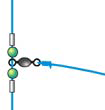
A much better approach is to tie the hook trace onto a swivel, and locate the swivel on the body line between a couple of beads and locking crimps. This gives the snoods a much better chance of dealing with any line twists caused by the bait flapping around as it flies through the air on the cast, or on its journey to the seabed. Bit of a clue there as to why it's called the flapper rig.
Use the Uni-Knot for making all the connections, unless the hook has a turned up or turned down eye - in which case connect the hook with the Snell Knot.
On a two or three hook flapper rig, the lower snood can be longer to give better bait separation on the seabed.
Tied in this way, they're known as '1up-1down' or '2up-1down' flapper rigs.
Flapper Rig Variants...
One-hook flapper rigs:~
- One up, or
- One down
Two-hook flapper rigs:~
- Two up, or
- One up, one down
Three-hook flapper rigs:~
- Three up, or
- Two up, one down
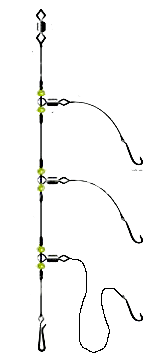 2 Up, 1 Down Flapper Rig
2 Up, 1 Down Flapper RigFor large fish and large baits then the single hook flapper rig is
the one to use. Conversely, for smaller fish and smaller baits, a two or
three hook flapper rig is the way to go. Remember that the more bait
you get out there, the greater will be the scent that will lead the fish
to your hooks - but the more difficult it will be to cast any distance.
Clipped Rigs; for Longer Range Surf Casting
Leaving the baits to flap around will take 20 per cent or more off your ultimate casting distance. A clipped surf fishing rig will solve this problem by streamlining the entire rig.
As you can see from the sketches below, clipped rigs are more complex than the flapper rigs, involving two additional components:~
- a bait clip for each snood, and
- a bait stop for each snood
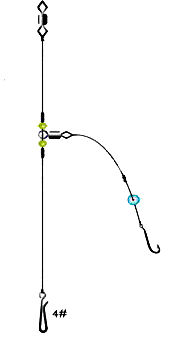 The single hook clipped-down rig is one of the best casting surf fishing rigs.
The single hook clipped-down rig is one of the best casting surf fishing rigs.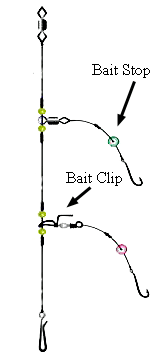 The two-hook version of the clipped rig; a favourite surf fishing competition rig.
The two-hook version of the clipped rig; a favourite surf fishing competition rig.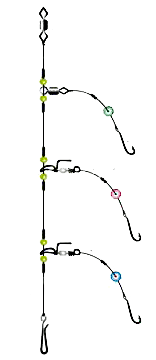 The three hook version of the clipped down surf fishing rig. Ideal for catching small fish at long range.
The three hook version of the clipped down surf fishing rig. Ideal for catching small fish at long range.One, Two and Three-Hook Clipped Rigs
Each of these 1, 2 and 3-hook clipped rigs terminates in a link clip rather than a bait clip, which means that an impact lead must be used to provide a clip for the lower hook to be clipped to.
In the 2 and 3-hooked rigs, the rolling swivel at the inner end of the dropper has been replaced by a cascade swivel which incorporates a clip for the hook above it.
Still with me? We'll take a look at the various options for clipping down your bait, then all will become clear...
Clipped Rig Accessories
First, the bait clip...
This is a small refinement to the link clip for connecting your casting lead to the end of the rig body line.
Nothing more in fact, than a simple bent down extension over which you slip the bend of the hook.
Now the bait will be held tight up to the lead weight during the cast, and will fall off when the rig hits the water - hopefully not before.
If you choose to use a link clip, then you'll have to also use either an impact shield just above it or an impact lead.
Impact Leads...
These are the impact leads described above, for use with a link clip.
These have the bait clip built-in alongside the attachment eye, as shown.
In strong tides you may have to go for the spiked version to keep the rig anchored where you want it.
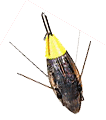
The Impact Shield...
Thirdly, you could use a standard link clip together with an impact shield.
These are threaded on the rig main body line just above a standard link clip.
They serve two purposes; first to provide a clip for the lower hook, and also to provide some protection for the bait as it splashes down at the end of the cast.
Cascade Swivels...
You can see how cascade swivels are used in the two and three hooked examples shown above.
The top hook is clipped to the cascade swivel of the second hook snood, and so on.
This works fine until you want to use a long 'down' snood on the lower hook. It simply fall off in mid-cast. Enter, the Loop Rig...
Bait Stops...
In all of the sketches of clipped rigs, you'll see a bait stop just above the hook. The reason for these is that, during casting, the clipped-down hooks fly 'bend first' through the air which blows the bait over the eye and up the snood - or it would, were it not for the bait stop to prevent this happening.
An un-clipped flapper surf fishing rig will allow the hook to fly 'eye first' which keeps the bait located firmly in the bend of the hook - so bait stops aren't needed.
The Loop Rig; for Casting Long Hook Snoods
The lower dropper in a '1-up, 1-down' or '2-up, 1-down' version of the clipped down surf fishing rig would be too long overall for all practical purposes - casting the beast would be a nightmare - but of course the ever-resourceful surf anglers have come up with solution.
It's called the loop rig. In it the cascade swivel is tied in the snood close to the hook. This clips the lower bait in tight and forms a loop in the line between the rolling swivel and the cascade swivel - ingenious or what?
There's no better long-range multi-hooked surf fishing rig.
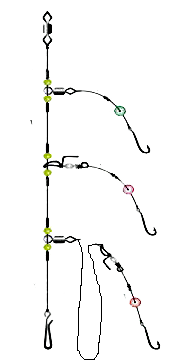 A three hook loop rig was developed for casting long-snooded clipped rigs long distances.
A three hook loop rig was developed for casting long-snooded clipped rigs long distances.One thing's for sure - you really don't want to be messing with multi-hook clipped rigs
or loop rigs unless you have to! My advice is to stick with flapper rigs unless it's
imperative to get your bait as far out to sea as possible. Keep it simple!
The Pulley Rig; for Fishing Over Rough Ground
Fishing over rough ground with a 2 or 3 hook rig is just asking for it, so you'd be wise to resist any such temptation.
Often though, it's the lead weight that gets caught up as it trails astern of a hooked fish. The Pulley Rig has been designed to eliminate this risk by allowing the weight of hooked fish to pull the lead weight into a position ahead of the fish, where it is much less likely to get hung up.
 Single Hook Pulley Rig
Single Hook Pulley Rig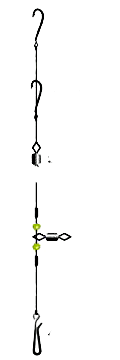 Pulley Pennel Rig
Pulley Pennel Rig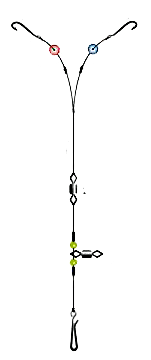 Pulley Wishbone Rig
Pulley Wishbone RigUsed with an impact lead or an impact shield, the simple pulley rig is capable of being cast very long distances indeed.
As a long range surf fishing rig it's often used with a tandem hook pennel rig for large baits - and big fish...
But if you really must use two smallish baits, then the wishbone rig version is the way to go.
Recent Articles
-
Sea Fishing Rods and Reels Must Be Compatible for a Balanced Outfit
Mar 08, 21 08:30 AM
A quality reel fitted to a quality rod doesn't necessarily make it a quality outfit. Your fishing rods and reels have to be properly matched if you're to get the best out of them, and here’s how -
Essential Lure Fishing Tips That All Saltwater Anglers Should Know
Mar 08, 21 04:51 AM
Which single lure fishing tip applies to trolling, jigging, baitcasting, spinning, fly fishing and any other branch of lure fishing? Well, it is the one at the top of this list -
Vital Jig Fishing Tips That You Really Cannot Afford To Miss!
Mar 07, 21 10:20 AM
Essential jig fishing tips to help you select the right lure for successful jig fishing, together with the techniques required to get the most out of your jig fishing outfit












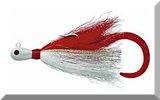
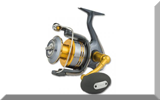
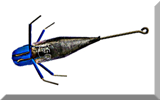
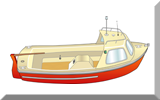
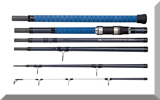
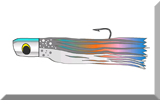
New! Comments
Have your say about what you've just read! Leave me a comment in the box below.